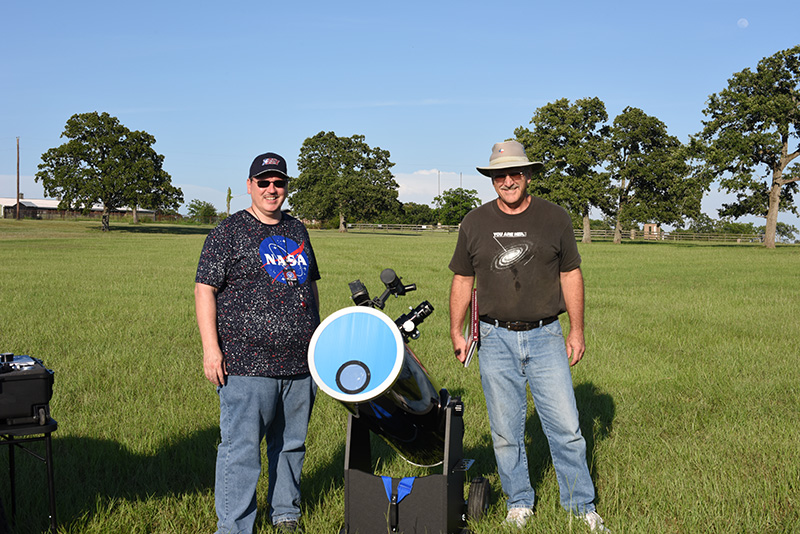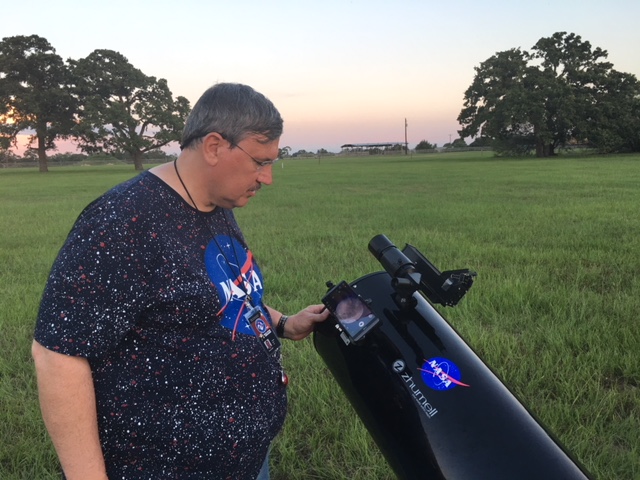
One of the lessons learned from yesterday's outreach is that standing in an open field in 90+ degree weather is downright hot!
Tonight, the Brazos Valley Astronomy Club was represented by Warren, Ginger and myself. We set up our Dobs in about the same spot as yesterday. I brought along Cutie again as well, but didn't set it up. We would have the same group of kids tonight and they seemed more interested in the big scopes, and who can blame them?
I asked Ginger to come to help document the occasion with her photography, and she readily agreed. This was a real blessing, as it allowed Warren and I to keep our focus on watching our equipment and keeping the kids engaged, while the club could still get some nice action shots to post on our website.
Warren and I both brought cold water tonight. We also brought mosquito repellant. It seems we learned our lessons well!
We doused ourselves in bug spray, set up our Dobs and outfitted them for solar use and took a peek. The same freckle was on the sun (although it had moved a bit since yesterday) but no other sunspots had popped up.

We didn't really see any point in having the kids look at the same sunspot as yesterday while it was this hot outside, so we decided to leave the scopes until sunset and go inside with the kids to do a bit of indoor astronomy with them instead until dusk.
After the kids had gathered inside the cabin, I passed out some copies of the current month's sky chart and taught them how to use it. Then I introduced the concept of red lights and asked them if anyone knew why astronomers used red flashlights instead of the regular white ones. One girl raised her hand and answered, "Because when you go outside after being in a bright room, it's hard to see the stars, but with the red light, it is easier." Smart girl!
Our host, Andrea, had bought flashlights, red cellophane and rubber bands for all the campers. Warren then showed them how to attach the cellophane onto the flashlight with the rubber band and make a red light. Equipped with red lights and a star chart, our young astronomers were ready for nightfall. I gave them all a NASA sticker as a reward for their patience with us.
While the campers ate supper, the three of us went back to the scopes to prepare for the evening under the stars. We removed the solar filters from our scopes and aimed at the moon.
Ouch! These mosquitos were really thick tonight. We all gave ourselves another generous dose of repellant.
We had a bit of time to kill while they ate, so I went ahead and connected my cellphone adapter to the eyepiece of my telescope and showed Ginger how I was able to take videos of the Moon a few months ago.

In the meantime, Warren had opened an app on his phone called SkEye and then attached his phoen with velcro to the tube of his scope. The app allowed him to align the scope to two or more targets and then it would act as a PushTo device, letting him enter an object and it would tell him where to aim his telescope to put it in the field of view. Very cool!
I spotted a couple of jets in the western sky, leaving their telltale contrails. One of them was heading roughly towards the setting sun and looked a bit like a comet, so I joked about the naked-eye comet. Warren pointed his scope to the plane and said it looked pretty neat. I aimed my scope with the cellphone still attached to the eyepiece and sure enough, with the Dob turning the image upside down, it appeared that the jet was rocketing towards space. I turned on the video recorder and made a short clip of it:
About this time, the kids showed up. Venus and the Moon were visible, so we began showing off the sky. I decided to leave my cellphone connected and showed the moon. They thought it was very cool that they could all see the moon at once and that I could pinch and zoom it.
The kids began complaining of mosquito bites, so we let them borrow our bug spray and they spent a few minutes applying it. Those bloodsuckers were really thick tonight.
I caught a flash in the south out of the corner of my eye. A bank of clouds showed a bit of lightning. They were several miles away, so I hoped they'd stay there.
As the skies began getting a bit darker, Jupiter became visible. We aimed our scopes in that direction and the kids were able to see that tonight, all four moons were on the same side of the planet.
Jupiter started blinking out again. What the...? I looked up. Sure enough, clouds were once again rolling in. On the radio as I was driving to the campsite tonight, the weatherman promised me that the skies would be clear all night tonight. What's going on? Don't these people have offices with windows?
A few of the brighter stars were visible despite the clouds. I was able to have them pull out their star charts and try to guess which stars they were seeing. It took a few tries, but they were able to identify Arcturus and Spica correctly.
My cellphone beeped. An Iridium satellite was scheduled to pass overhead in a few minutes. Awesome! But would we be able to see it between clouds?
I drew the approximate path with my green laser and we all looked, but never did spot it. Not really surprising as over 90% of its path was obscured by clouds. I was really hoping to show them M13 tonight, but the sky just wasn't cooperating.
The kids were getting restless and wanting to get away from the mosquitos, so we once again called it a night. They thanked us before leaving and said that seeing the green laser in the sky was the highlight of the night for them. Oh well, we tried. At least it didn't rain on us.
As they were all heading back to camp, Andrea came up to me and gave me a hug and thanked us all for coming out and making this a memorable experience, despite the weather and bugs working against us.
The next camp session is in a couple of weeks. I'm really looking forward to it. I have a fresh supply of bug spray, a cooler ready to be filled with ice water, and an umbrella in case of rain. Bring it on!